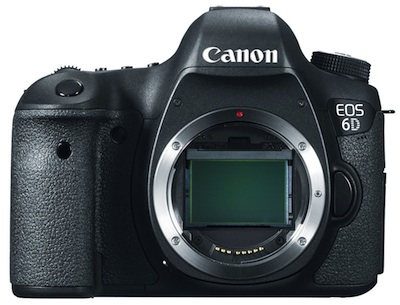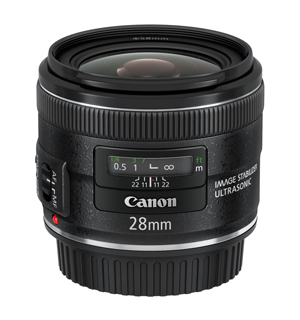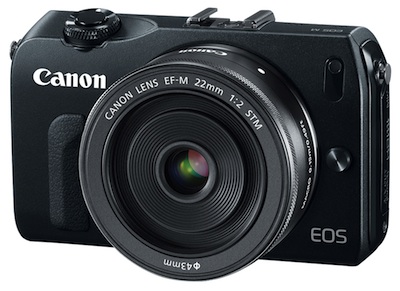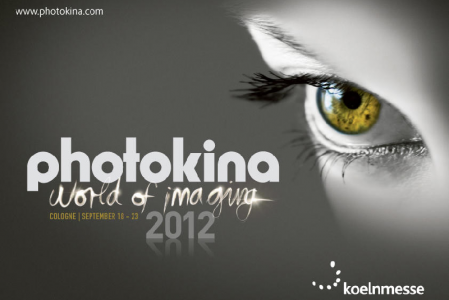Q&A with Canon’s Mike Owen: A behind-the-scenes look at developing the 6D and what’s next
posted Thursday, September 20, 2012 at 3:53 PM EST

Mike Owen, Professional Image Marketing Manager at Canon Europe Ltd.
Imaging Resource Founder and Publisher Dave Etchells caught up with Mike Owen, Professional Image Marketing Manager for Canon Europe Ltd., at Photokina 2012. Owen discussed the technical tradeoffs Canon had to make in developing the 6D, the company's overall product strategy for its DSLRs and lenses, the importance of camera WiFi connectivity and other future photography trends.
Dave Etchells/Imaging Resource: I guess we might as well start out with the 6D. Obviously, that's the big news. There's been some discussion online about the 6D having a smaller number of AF points than previous Canon DSLRs and, in particular, the single cross-type sensor in the middle. Is there a downside to offering more cross-type points or is it a cost issue? Is it a matter of product differentiation among your line?
Mike Owen/Canon: It's a variety of reasons, really. I mean, yes, there is the cost side of things, but what we've tried to do with the autofocus system on the 6D is to actually improve low-light performance. It goes down to EV -3. So when emphasizing low-light performance, we've always had to make elements of the AF system larger, which limits our ability to put in more cross-type points.
DE: So it's a conscious design decision. You really wanted to emphasize low light.
MO: Yes, absolutely. It was a decision that we felt that this type of camera in this particular user group, auto focus performance is not 100% critical. But low-light performance for autofocus is important. And it's just about that trade off.
DE: That leads to one of the other questions we have which is the pixel count. There's been a lot of discussion back and forth online about the sensor resolution. You know, some people are saying, "Well, I wish it had 36 megapixels." Other people are saying, "No, I'm glad it doesn't because I prefer the low light and more manageable file sizes." And so I guess the question is, what was the thinking that lead specifically to a 20.2-megapixel sensor?
MO: We very much feel that that resolution, 20 to 22 megapixels on a full frame sensor is the real sweet spot. It's the maximum that we can get to without starting to see a conflict between noise performance and resolution. And obviously, what we want to try to do is give you the best possible balance. And over the last few years, what you've seen is that other manufacturers have been sort of creeping up with their resolution. But we've reached a sort of sweet spot since 5 years ago when we launched the 1DS Mark III. And we think that, at the moment, that is the better place to be in terms of performance, allowing people to have the high ISO capabilities--high as you're able to get with the current Canon range as well as the high resolution and image quality.

DE: Who really are the target users for the 6D? Who did you design it for and who did you explicitly not design it for?
MO: Well obviously, we didn't design it for the sports and wildlife photographers. But we did design it for the portrait photographer who wants to shoot in natural light, who wants to be able to use the natural highlights of shooting in dusky and indoor conditions without the need for having external light. It's also for the landscape photographer who wants to be able to just shoot and travel all day with a camera to get where he wants to be, to get his shot. And because given the weight of it, at 770 grams, it's a nice, lightweight body. So really, it's targeted to a variety of user bases but ultimately, it's the photographer who wants to travel light and move quickly but still not compromise on image quality.
DE: On another point, some of our readers want to know, why only a three-shot HDR (High Dynamic Range) mode on the 6D? It looks like it could be a nice landscape camera, but for HDR they really want more than three shots.
MO: It's one of those elements that can be a little bit divisive. Some people want more shots, some people don't and it goes down to the application of the user. And what we always try to do with all of our products is listen to photographer feedback. As you've seen over the recent generations of our products, we've actually been including additional functionality through the life cycle of a product through firmware updates. But for now, we think that this offers a good balance between usability and functionality. [Editor's note: The Canon 6D supports AE bracketing with 2, 3, 5 or 7 shots, so HDR processing with more frames is still possible using software after capture.]
DE: We liked that the 6D is equipped with WiFI and GPS. Was the decision to include WiFi in the 6D motivated by online connectivity, or was it more about adding camera functions such as remote viewfinder or that sort of thing?
MO: A bit of both. We know that a lot of travel photographers like to blog when they're traveling, so this is an easy way that they can put the image straight on to their smartphone and send it out. It does also allow you to set your camera up and then use your smartphone to trigger and control your camera. So it's just a bit of a natural progression. As you're aware, we've had EOS Utility in the box of our cameras for year. We're just starting to bring that to another generation of users as well.
DE: Here's another question from our readers: Why isn't there a tilt-swivel screen on the 6D? A lot of our readers seem to like the articulated screen which is kind of a Canon trademark. I think you guys actually own intellectual property on that feature, which explains why some of the other manufacturers haven't had it.
MO: It's one of those features that you have to, again, create a balance and, in particular, consider the durability element. For me, the idea is this camera needs to be lightweight and needs to be durable. And anything that detracts from the durability or the weight is something that necessarily we didn't want to include in this particular model. We didn't think the tilt-swivel screen was the right thing to add in this particular product for our target audience.
DE: A photographer that wants to travel light and is on the go means they'll likely throw it into a gear bag or something. And an articulated screen is just one more thing that can break.
MO: Exactly. And a photographer in the field, again, if they have a smartphone with them, they can use the smartphone as an alternative screen.
DE: That's a good point. Moving along to lenses briefly. Since sensor resolutions have been rising, how concerned are you about the optical quality of the lenses matching up? Do you feel pressure to increase the lens performance in the face of this increasing resolution on the sensors?
MO: Back to the point early about us sort of having this 20-megapixel sweet spot, I think that all of our lenses work more comfortably with that resolution. And what we do is -- as new technologies come into lens development -- then we add the lens to the range when we refresh a lens. So whether it's things like the SWC [Subwavelength Structure Coating] lens coating or the anti-reflective coatings or the new fluorite to make the weight reduction, we always try and update our lens range at a reasonable pace and add in new technology as and when we can. But in terms of actual resolution, we don't see that to be a problem with the entire current EF lens range and the resolution that we're including in our current range of products.

DE: Two of your latest lenses, the EF 24mm f/2.8 IS USM and the EF 28mm f/2.8 IS USM have been long awaited by enthusiast photographers. But many were surprised by the higher price for them, particularly for non-L lenses. I think their $850 and $800 respectively in the U.S. Are we seeing the impact to the exchange rate, or is it just more expensive to design a lens these days? Or is there some particular performance considerations that pushed you in that direction?
MO: With these new lenses we've included IS which is an additional cost to a non-IS lens. And we always are trying to make sure we get the best possible image quality. And the feedback we had, it's that the 24mm and 28mm are optically very strong. We've utilized the latest optical technology to get the best possible image quality out of it. When people say the price has been going up with lenses all the time, they often cite the cost of the 400mm, 500mm and 600mm lenses. But you need to think back to the price point of when we launched lenses and compare that to when we replace them. So if you take the 600mm, for example, we launched that, I think, in 1999 – at the equivalent price of about 12,000 Euros. We launched the new 600mm lens in 2012 at a current price point of around 12,000 Euros. It's been on the market for 11 years and you can’t compare the price point then versus a brand new lens with the latest technology.
And to answer your questions about exchange rates, yes, the exchange rate always has an impact on what would affect pricing in every region in the world. I mean, U.S. versus Japan, if the exchange rate changes, we're always going to see differentials. But we always try and price our lenses in a way that reflects the latest technology that comes into those units.
DE: With the 24mm and 28mm lenses, it sounds like the optical performance was a very strong goal and so that might have traded off against a lower price.
MO: Exactly, exactly. We wanted to make sure that we gave the best possible image performance out of those two lenses and we've had very favorable feedback from the photographers who've had the opportunity to use them in the field. And whilst many photographers may have sort of originally dismissed the idea of having IS in any very wide-angle prime, actually, when they started to use it, they said, "Oh, there’s a benefit. We can see the benefit." The pros that we talked to think that the 24mm and the 28mm are very cheap for what they're getting for those lenses.
DE: I can see how people first thought, "Well, it's wide angle. You can shoot at slower shutter speeds anyway. You don't need IS.” But I guess there are always situations where you need more light than you have.

What's really the distinction between a high-end non-L lens like the new wide angles and a traditional L lens?
MO: An L lens has to meet a few key standards and two of those are the build quality and the weather sealing which we put in to a vast majority of our L lenses. And an L lens also has to meet certain optical standards to be that. So it's a combination of build quality and optical standards.
DE: And so looking at these new non-L primes, it's that they're well built but they're not ruggedized the way that an L would be?
MO: They're not weather-sealed.
DE: Looking at the other end of the lens line, there's been a lot of interest in the 40mm STM. It seems very popular. It's an inexpensive lens. It's the pancake, small form factor. Will we expect to see more activity at that end of the lens line, too? Will we see more similar, inexpensive, good quality primes?
MO: This year we've launched a lot of prime lenses. Whether it's the 22mm for the EOS M, the 40mm pancake lens, whether it's the wide-angle 24mm or 28 mm prime lenses are something that we have been very keen to try and make sure that we fill some gaps in our marketplace. Ultimately, we listen to users' demands. Photographers have been telling us that they wanted a slim, lightweight standard lens and the 40mm pancake definitely fit that requirement. And if there’s an additional requirement from our user feedback, if they want other lenses to fill holes in the gap, then we will try and fulfill those demands as much as we can.
DE: Speaking about gaps, another of our readers asked if you are going to do any more high quality EF-S lenses, particularly in the telephoto range. Because he said there's a budget 55-250mm but there really aren't any other high-end EF-S telephotos.
MO: One of the reasons why we manufactured EF-S lenses to start with was to be able to provide wider angle lenses for smaller sensors. So you start getting into the telephoto lenses, then we already have quite a substantial range of telephotos that fulfill the requirements of photographers at those sort of focal lengths.
DE: Of course you know, a full-frame tele lens is going to have a lot more mass there because of its larger image circle. So that may be the direction that the reader is asking. He wants something that’s a little more compact than 70-300mm.
MO: Again, it's one of those things that we will continue to study in the market and see where we get.
DE: Regarding the market in general, we've been seeing a greater emphasis on cameras aimed at the enthusiast photographers rather than pure consumer offerings. I guess you're on the pro side so this is maybe outside of your sphere a little bit. But I'm curious whether Canon sees the enthusiast market growing as well, and how do you plan to take advantage of that growth?
MO: To be honest, the 6D is absolutely targeted in that arena. It's targeted at the mid-range, guys who aren't pros but have photographic skills and they really want to get the best out of their cameras. They know how to shoot but they don't necessarily have the budget to buy a professional-level camera. And between the 6D and the 7D, we're giving the user a choice. If you want to shoot your sport or your wildlife, then we have the 7D offering for you. If you want to shoot portraits or weddings or in lower light situations, then we now have the 6D. And those two products are really designed to complement that enthusiast marketplace. We want these photographers to get the best shot without necessarily having to make a huge investment.
DE: Do you think you're seeing a growth in the enthusiast market?
MO: We're seeing a growth across the board. We've had fairly solid performance over the last couple of years in the SLR world. We really do think that there is the ability to grow in all of the marketplaces and we're always trying to listen to our users and respond with products that fit their requirements.
DE: So you really aren't seeing a differential growth. It's pretty even across the board for you.
MO: Yeah, it's fairly consistent.
DE: There's traditionally been some SLRs in the Canon line up that kind of sit between the consumer and the pro. The 60D is an example. Without getting too specific, how well do models like that sell relative to the ones that bracket them on either the consumer or the pro side?

MO: We haven't had any product that hasn't really performed to its expectations. And what we find is that you can design a product for one user group but actually it could be accepted by a wide variety of users. I know many professional photographers that, because of the form factor, will use the 60D because it fits their requirements. And we see a lot of them use two different cameras as their tools. They'll use the tool that's right for their job on that particular day, same as any other tradesman would. For example, National Geographic photographers might put a 600D [Rebel T3i] in a camera trap because it's a relatively low-cost camera and it doesn't matter if it gets trashed. But they're not going to do that with their 1Ds or their 1DX.
DE: As we're seeing more and more SLRs out in public, in the hands of consumers, we've heard that there's a lower lens-attach rate [the number of lenses owned by a typical photographer] overall. However, Canon recently announced the production of its 80 millionth lens. How is the lens-attach rate doing in 2012 with SLR photography taking off with the general populace?
MO: We don't have specific figures on that, but we do know that we are seeing lens sales grow. I mean, we celebrated 80 million lenses very recently but only celebrated 70 millionth sold last year. So that's 10 million lenses in a relatively short period of time.
DE: That’s amazing.
MO: And we're seeing that figure accelerate at the moment, year on year. What we do know is that as photographers move up the range of our products, the attachment ratio increases. So our lowest attachment ratio would generally be with our 1100D [Rebel T3] users, and our highest will be with the 5D Mark III and 1DX, and that's no surprise. And what you see is, as people invest more, the body starts to rotate faster than the lenses do. Because as a photographer yourself, you know that if you put your lens in your kit bag you've had for years…
DE: Oh, yeah. I still have the lens I used in high school.
MO: Exactly, and that's still the way. You invest in the lenses and the body becomes what rotates through.
DE: This is a question from one of the editors. I'm not sure how you really could answer it, but I'll ask it anyway. So looking into the future, looking into the crystal ball, what do you see as the major features of the cameras that will be selling in 2015?
MO: I mean, that is the multi-million dollar question and if we could predict the market today, we'd all be rich.
DE: Yeah, if you knew the answer to that, you wouldn't be sitting next to me right now.
MO: Exactly. I'd be out selling products. If you look at what we're doing across the range, across all of our products, the way forward is really all about connectivity. And whether it's the EOS M, the 6D, the latest range of IXUS and PowerShot cameras, the new Selphy printer, whether it's Project 1709… it’s all about connecting users and photography together. And I think we'll continue to see that developed within the Canon range over the next few years.
DE: We're seeing a huge emphasis on connectivity with mobile devices and social media. You've begun to address it with WiFi in the 6D and some of the PowerShots. How likely do you think WiFi will really become almost ubiquitous at some point? Is that going to be something people will just take for granted in the cameras?
MO: I think it will get to that point and we know there is an audience out there for it. Image quality is still really important and, at the moment, is not answered by other devices other than dedicated cameras. So, ultimately, we're now just providing that step where you're able to get the image quality you want and also able to send it out and share it as quickly as you would using a mobile device.
DE: We're starting to see cameras with operating systems built into them. Has Canon looked into integrating operating systems like Android, or do you think that embedded software with WiFi is really sufficient to address the connectivity requirement?
MO: You've worked in the industry a long time, so you know that Canon has three core principles we follow based on the EOS system that was built 25 years ago: Ease of use, high image quality and speed of use. And to that end, we need to make sure that -- whatever we do with any of our products -- there's no compromise those three core principles. And we need to see where the market goes. Is it a user demand that can be fulfilled? At the moment, it's still very, very young and very fresh and we will continue to look and study as we did with the compact system camera market. We wanted to make sure that when we brought products to the channel in the CSC market, that it was a product that fulfilled those key principles of the EOS range and the user feedback that we had.
DE: Tell me about Project 1709 and Canon’s initiative to get images onto the Web. What do you think is the most important aspect of that project? You know, what would attract people to it? What's the value proposition for them?
MO: At the moment, we're still very early in the beta phase. But the key idea behind Project 1709 is making sure that people can have their images in a single location that they can access, that they can tie into their Facebook and Twitter feed and all of these sorts of areas, very simply, very easily and very quickly. And it's not just a Canon ecosystem. It could be images from other platforms as well.
DE: And so it's differentiated from Facebook in that it's a more purely photo-centric…
MO: Yes, you can upload your photos from your camera to Project 1709, whatever its final name may well be. And you can then consolidate it so you can have your photo there that will integrate with your Facebook profile as well as your Twitter profile, and whatever other social network you use. Your photos are kept in a single location.

DE: You mentioned compact system cameras a little earlier. They've become a huge force in the Asian market, and they're beginning to really finally get some traction in the enthusiast market in the US and Europe. A question from one of our editors concerns the EOS M. Was that just a first entry into the CSC market with more already planned to come, or was it a little bit more of a market test to see how people respond to its particular combination of size, features and performance?
MO: CSC was a huge topic of discussion at Photokina two years ago. And every interview we did was centered on that topic, asking when were we going to do something. What we concluded then is that we will study the CSC market, we will look at it, and we will try and develop something. Now if you look at what happened with the EOS system when we launched that in 1987, we launched it with a few lenses and one body. And you see how the system has grown and so has user demand. So Canon then decided we wanted to take that same approach with a compact system camera. It took us a couple of years, then we launched a Pro EOS system. Now we have the EOS M, and we will see how it's adopted by the marketplace.
DE: What's the most interesting non-Canon announcement or news you've followed at the show?
MO: The truth is I haven't had much of a chance to look around. I don't think there's a huge step-change like we saw two years ago with compact system cameras. I think what we're seeing is an evolution of products that are already on the marketplace. I think the industry is studying very carefully what the next big step is. So, for me, I see Photokina 2012 as an evolutionary Photokina.
DE: Mike, thanks very much for taking time out of your very busy schedule to talk with us.
MO: It was a pleasure, as always, Dave.
